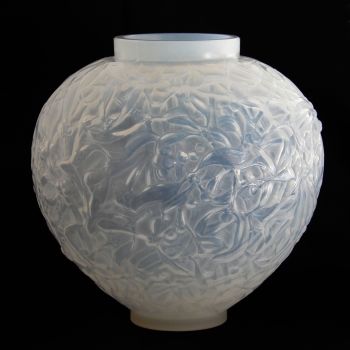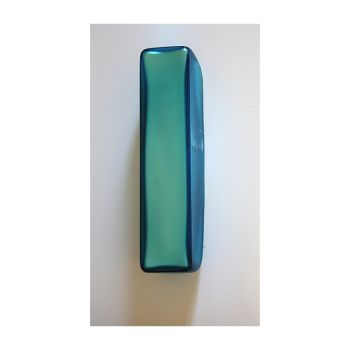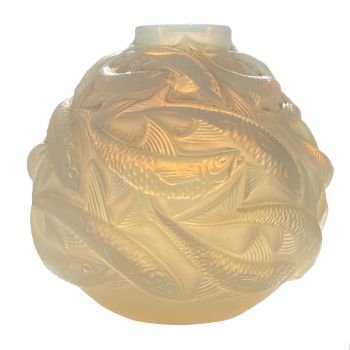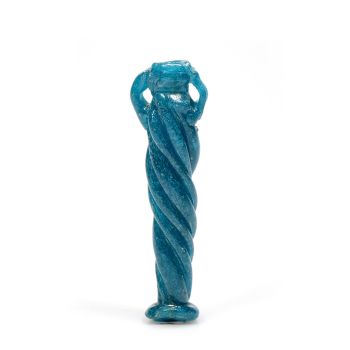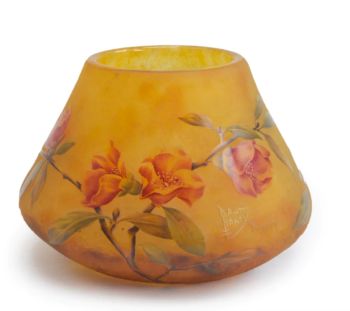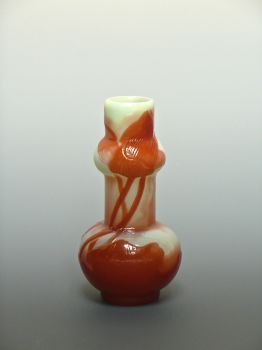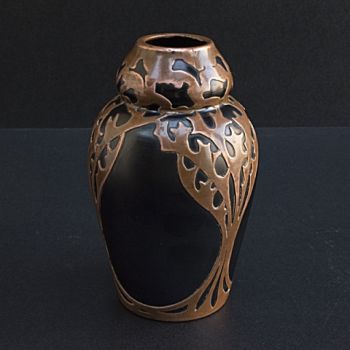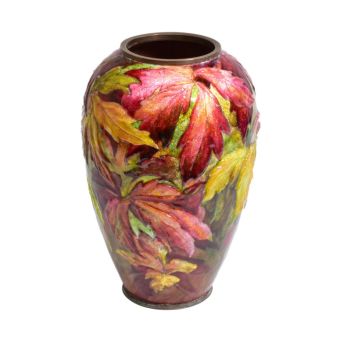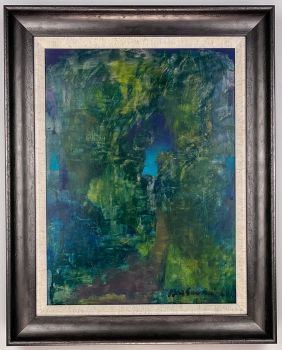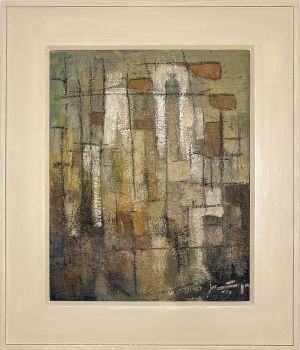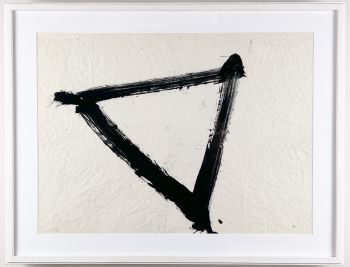A set of two sizes Art-object, model SH 117, Nuutajärvi-Notsjö Finland 1958 & 1959 1958 - 1959
Saara Hopea
Glas
5 cm, ø 13 cm
ConditionVery good
€ 1.100
Van Kerkhoff Art
- Über KunstwerkTwo mold-blown, clear, dark-blue and moss-green cased glass Art-objects / bowls, model SH 117. Designed by Saara Hopea in 1956 and executed by Nuutajärvi-Notsjö in 1958 & 1959.
An optical effect makes it appear as if the colour goes to the outer edges but the encasing is only in the interior.
These objects were made between 1956 and 1967 in two sizes 9,5 cm and 13,5 cm in diameter, and in several colours (blue, green, yellow, purple and red) this being a complete set in green and blue. Both are early production examples.
They are marked and dated in diamond pen underneath the base.
Two mold-blown, clear, dark-blue and moss-green cased glass Art-objects / bowls, model SH 117. Designed by Saara Hopea in 1956 and executed by Nuutajärvi-Notsjö in 1958 & 1959.
An optical effect makes it appear as if the colour goes to the outer edges but the encasing is only in the interior.
These objects were made between 1956 and 1967 in two sizes 9,5 cm and 13,5 cm in diameter, and in several colours (blue, green, yellow, purple and red) this being a complete set in green and blue. Both are early production examples.
They are marked and dated in diamond pen underneath the base.
About Saara Hopea
Saara Elisabet Hopea (Porvoo 1925 – Porvoo 1984) was a Finnish designer of Art-glass, furniture and jewellery.
Saara Hopea was born in 1925 in Porvoo, in the south of Finland. Her parents Ossian Hopea and Lempi Westerlund owned a goldsmithing company.
After attending secondary school, Hopea studied at the Interior Design Department of the Central School of Art and Design, now the Aalto University of Art and Design.
She graduated in 1946, and worked for a few years as an illustrator, then she accepted a job at the lighting factory of Taito Oy, headed by the renowned designer Paavo Tynell.
In the early 1950’s, Saara Hopea became interested in glass design and started working at the Nuutajärvi glass factory, where she worked under artistic director Kaj Franck.
After her father’s death, Saara Hopea took over the direction of the family business Ossian Hopea Oy in 1959. She worked as the artistic director from 1959 to 1960 and again from 1967 and was responsible for numerous jewellery designs.
In 1960 Saara Hopea married Oppi Untracht , an American goldsmith, photographer and writer, and they moved to New York City. Together with her husband, Saara Hopea also lived in Nepal and in India over the years until 1967, after which the couple settled permanently in Porvoo.
For her glass designs, Saara Hopea received a silver medal at the Milan Triennials in both 1954 and 1957. She also received the Porvoo City Culture Prize in 1981 and the State Arts and Crafts Prize in 1982.
Her retrospective exhibition was held at the Museum of Arts and Crafts in Helsinki in 1987. 28 of her works are in the collection of The British Museum in London and the MoMa in New York holds 11 of her works.
About Saara Hopea
Saara Elisabet Hopea (Porvoo 1925 – Porvoo 1984) was a Finnish designer of Art-glass, furniture and jewellery.
Saara Hopea was born in 1925 in Porvoo, in the south of Finland. Her parents Ossian Hopea and Lempi Westerlund owned a goldsmithing company.
After attending secondary school, Hopea studied at the Interior Design Department of the Central School of Art and Design, now the Aalto University of Art and Design.
She graduated in 1946, and worked for a few years as an illustrator, then she accepted a job at the lighting factory of Taito Oy, headed by the renowned designer Paavo Tynell.
In the early 1950’s, Saara Hopea became interested in glass design and started working at the Nuutajärvi glass factory, where she worked under artistic director Kaj Franck.
After her father’s death, Saara Hopea took over the direction of the family business Ossian Hopea Oy in 1959. She worked as the artistic director from 1959 to 1960 and again from 1967 and was responsible for numerous jewellery designs.
In 1960 Saara Hopea married Oppi Untracht , an American goldsmith, photographer and writer, and they moved to New York City. Together with her husband, Saara Hopea also lived in Nepal and in India over the years until 1967, after which the couple settled permanently in Porvoo.
For her glass designs, Saara Hopea received a silver medal at the Milan Triennials in both 1954 and 1957. She also received the Porvoo City Culture Prize in 1981 and the State Arts and Crafts Prize in 1982.
Her retrospective exhibition was held at the Museum of Arts and Crafts in Helsinki in 1987. 28 of her works are in the collection of The British Museum in London and the MoMa in New York holds 11 of her works.
Marked
Marked in diamondpen underneath the base: S. Hopea Nuutajärvi-Notsjö '59 (1959) & '58 (1958)
Execution
Nuutajärvi-Notsjö glassworks, Finland 1958 & 1959
Condition
These Art-objects are in good vintage condition. Some scratches on the side and several deeper scratches underneath the base. Basic wear consistent with age and use. No chips or cracks.
Literature
Oppi Untracht – Saara Hopea-Untracht: her life and work.
Dimensions
Height 5,16 & 4,42 cm
Diameter 13,56 & 10,6 cm
Weight 1443 & 775 grams - Über Künstler
Saara Hopea hatte eine produktive Karriere in verschiedenen Designbereichen und hinterließ einen bedeutenden Eindruck in der finnischen Kunstlandschaft der 1950er Jahre. Ihre Reise begann im Bereich des Möbeldesigns, wo sie von 1946 bis 1948 ihre Fähigkeiten verfeinerte. Auf der Suche nach neuen Möglichkeiten schloss sie sich dann mit der Firma des renommierten Metallschmieds Paavo Tynell zusammen, wo sie bis 1952 arbeitete.
Während dieser Zeit leistete sie einen Beitrag zur Glashütte Nuutajärvi, wo ihre Kreationen zu einer leuchtenden Verkörperung der minimalistischen Ästhetik wurden, die den finnischen Stil in den 1950er Jahren prägte und von den Prinzipien der Bauhaus-Designphilosophie beeinflusst wurde. Insbesondere nach dem Tod ihres Vaters im Jahr 1948 übernahm sie die Aufgabe, Silberwaren für sein Geschäft in Porvoo zu entwerfen.
Ein Wendepunkt in Hopeas Leben ereignete sich, als sie heiratete und mit ihrem Mann nach New York zog. Hier beschritt sie einen neuen künstlerischen Weg und erkundete den Bereich der Emailarbeit. Durch ihre Experimente mit überbrennenden transparenten Emails auf Kupfer erzielte sie bemerkenswerte Ergebnisse, die ihren Stücken ein spontanes und malerisches Aussehen verliehen, das sich durch lebendige Farben und bemerkenswerte Tiefe auszeichnete. Ihre exquisiten Emaille-Kreationen gelangten über exklusive Geschäfte in die Hände anspruchsvoller Kunden.
Der Wissensdurst und die künstlerische Inspiration des Paares veranlassten sie zu einer bemerkenswerten Reise durch Nepal und Indien, die sich über vier Jahre erstreckte. Während dieser Zeit vertieften sie sich in das Studium, die Fotografie und die Sammlung lokaler Metallarbeiten und Schmuckstücke. 1997 veröffentlichte ihr Mann, stark beeinflusst von ihren Erfahrungen, „Traditional Jewelry of India“, ein Zeugnis ihrer Erkundung und Wertschätzung des reichen künstlerischen Erbes der Region. 1967 kehrten sie nach Porvoo zurück, wo Hopeas künstlerische Bemühungen ein breites Spektrum an Disziplinen umfassten, darunter Silberschmiedekunst, Textildesign und Emaillieren.
Die Wirkung von Saara Hopeas Talent und Kunstfertigkeit reicht über die Grenzen Finnlands hinaus. Das British Museum verfügt über eine Sammlung von 28 ihrer Werke, während das Museum of Modern Art 11 wertvolle Stücke besitzt, die von ihrem bleibenden Erbe zeugen. 1988 veröffentlichte ihr Mann einen umfassenden Bericht über ihr Leben und Werk mit dem Titel „Saara Hopea-Untracht: Leben und Werk“, der die bemerkenswerte künstlerische Reise dieser ruhigen skandinavischen Visionärin beleuchtet.
Sind Sie daran interessiert, dieses Kunstwerk zu kaufen?
Artwork details
Related artworks
- 1 - 3 / 3
Børge Mogensen
Teak wood “dropleaf” desk – Søborg Møbler, Denmark circa 19551950 - 1960
Price on requestVan Kerkhoff Art
1 - 4 / 24Frères Daum
Daum Nancy – “Paysage Soleil Couchant” vase with two applied handles1900 - 1910
Price on requestAntiques Emporium
1 - 4 / 24Unknown artist
François-Théodore Legras – Tall “Fleurs de Pommier” apple blossoms vase1900 - 1909
Price on requestAntiques Emporium
Unknown artist
Cristallo façon de Venise Drinking Glass1600 - 1650
Price on requestPeter Korf de Gidts - Antiquairs
1 - 4 / 24- 1 - 4 / 12



































